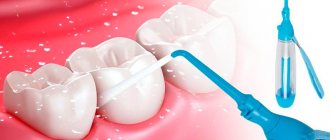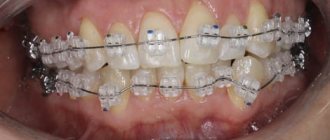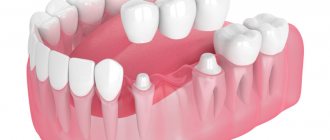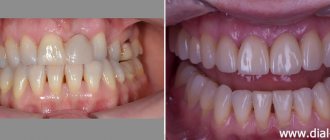What prostheses can be placed in the smile zone - the most complete list of solutions and their features
Article navigation
- Indications for prosthetics
- Important Features
- Prosthetic options
- Removable prosthetics
- Fixed dentures
- Implantation of incisors and canines
- Which dentures are better?
- Which material to choose
- In what situations is enamel grinding not necessary?
- Periodontitis and periodontal disease
- Contraindications
- Dentists' recommendations
- Price
Question for a specialist
People practically do not use incisors for chewing food, which is why when restoring them, high demands are placed mainly only on aesthetics and restoration of the correct bite. It is very important that your smile looks natural and natural. However, the material must still be strong enough to withstand the average load of biting food. Because of all these features, prosthetics of the front teeth contains many nuances, which will be discussed further.
Indications for prosthetics in the smile area
When thinking about prosthetics for the upper or lower front teeth, you need to know in what cases it is necessary. It is clear that the complete absence of an incisor or canine tooth along with the root is a direct indication for prosthetics. But there are other cases when it is a prosthesis in the classical sense that is needed, and not a filling. Let's look at the main indications for prosthetics in the smile area:
- chipped crown: the defect is more than half of its original size,
- cracks in the enamel or its abrasion,
- malocclusion: only in case of minor pathologies it is corrected with dentures, otherwise braces/aligners (orthodontic aligners) are needed,
- frequent caries under fillings,
- enamel defects: darkening, smoker’s plaque, “tetracycline” staining, fluorosis, thin enamel layer,
- complete absence of a tooth along with the root.
That is, prosthetics are necessary to recreate the aesthetics and functionality of a smile, as well as to create a more attractive appearance. The latter is especially true for public people and women.
Important features of restoration of incisors and canines
Features of prosthetics of the anterior teeth of the lower and upper jaw are as follows:
- it is important to recreate the aesthetics of the smile and face: choose the right shape and color of dentures that are identical to the enamel of neighboring units of the dentition,
- it is important to pay attention to the position of the gums: the contour of the mucous membrane should be natural and natural,
- it is important to ensure good fixation of the prosthesis: so that a person can not only smile, but also bite and chew food normally (although biting off very hard foods will no longer be possible in any case),
- It is important that the restoration does not cause discomfort and does not provoke pathologies: allergies or inflammation.
South Korean implant Osstem - from 35,000 rubles.
Hurry up to sign up for a free consultation and lock in promotional prices.
Call now or request a call
Opening hours: 24 hours a day - seven days a week
Approximate cost structure
Dental expenses:
- Rent of premises (direct treatment room, area for equipment, reception).
- Salary of a doctor, assistant and clinic administrator. In “White Rainbow” we simply don’t have random doctors - we are looking for the best on the market. And at the same time, their working day is not 8 or 12 hours, but from 8 to 15 and from 15 to 22 - when the clinic is open from 8 to 22. Because this is the optimal time when the doctor is fresh.
- Disposal of waste (gloves, patient organs).
- Equipment (purchase and maintenance, spare parts). The same tomograph costs 5 million, and it is basic for most diagnostics.
- Consumables (for example, implant). Here it must also be said that we buy a lot of things for dollars or euros with conversion into rubles, so in the outside world everything is becoming more expensive. The same implants, for example, are produced in the Russian Federation. But there is not a sufficient evidence base for us to look into the patient’s eyes and say: “Here, I’ll give you Russian implantation now, everything will be fine.”
- Compliance with sanitary and epidemiological regulations, starting from the correct sterilization of all instruments and ending with surgical protocols, including isolation. The same good keratotome (scalpel) is used in ophthalmology to cut off a piece of your eye, and in our case it is used for one cut during surgery. A unit costs approximately 1,500 rubles, and after three seconds it goes into the trash bin. Moreover, this is biological waste, there is blood on it.
- Training of specialists. In addition to regular courses, we have video recording of procedures, photographic recording (which is uploaded to you immediately) and all examinations and surveys conducted by phone. That is, doctors regularly cross-review each other, and at the end of the month and quarter they hold retrospectives to compile statistics. And if it is not an order of magnitude lower than the usual level of complications around the world in the same cases, it means that either the doctor is doing something wrong or choosing the wrong methods.
- Modern protocols (the same high-tech) - for example, when we place an implant, we always use a navigation template. That is, we carry out several diagnostic procedures to obtain both a 3D model of the oral cavity using an intraoral scanner and the location of the blood vessels and bones using tomography. Then we design the implant in special software, make sure that the crown on it will fit perfectly in the project, and then create a navigation template for the surgeon so that the cutter does not deviate by a degree or a tenth of a millimeter - and will not damage either tissue or nerves . As a result, the percentage of complications is lower, and the service life of the implant is significantly longer - as a rule, forever for an individual human individual. Navigation surgery alone requires both a 3D printer right in the clinic and a person who will work with it.
Let's look at implantation (tooth replacement), a rather expensive procedure.
The screw itself costs 5–10 thousand rubles. 5 - good, 10 - excellent. This is money for the fact that it is well thought out and that there will be spare parts for this screw in 20 years - otherwise we had a case when a patient needed five units for old, old implants that were no longer supported, and we called out to our colleagues’ clinics , we found four around the world, but the fifth still had to be solved creatively. To install an implant, you need a physiodispenser; this is a device that rotates the instrument with the required force to install the implant into the bone. You can turn it with pliers, or you can turn it with this device from 150 thousand to 1.5 million. Another set costs about 2 thousand euros, which contains all sorts of connectors for this implant. Yes, when you buy hundreds of implants, they give you this set for the clinic. But we have many clinics, and each one needs two sets, because they are rotated: while one is being sterilized, the other is in work. There are also two dispensers per clinic: only their motor is not sterilized. We also need tips for proper operation, of different types, attachments for piezosurgery. We need a warehouse of spare parts, for example, special screwdrivers. For all this to work, you need navigation, I wrote about it above. And a scanner. The last scanner cost 45 thousand euros. Then you need a temporary overlay - a CNC router, a mill in the jargon. The mill costs another 35 thousand euros. And a person who knows how to manage it. Plus a temporary crown from a 3D printer (and its installation) - it turns out that one correctly made new dental prosthesis on an implant, which will serve with a guarantee and will be highly aesthetic, costs just under 200 thousand rubles. And if you haven’t brushed your teeth for long enough and by the age of 45 you need to take half your jaw apart - consider it. This is still without bone grafting, if the teeth were all in place when you came to the clinic, or if you are just coming out of a fight and are carrying two of your own and one of someone else’s (as one patient did, and, in anticipation of important questions, someone else’s will not be useful). Patients, by the way, understand all this only when they are already faced with problems. For example, when their eye-placed implants have been subjected to an incorrect load for years, which ultimately compromises the aesthetics. When they understand that an implant is not for life, and they want guarantees. And the same people act completely differently in the case of cardiovascular surgery.
Here's another example. We have an orthodontist consultation for 4,500 rubles lasting five minutes.
This surprises patients to some extent. The purpose of the inspection is to check that the process is going correctly. In a regular clinic, it takes half an hour - the doctor looks into your mouth for the same five minutes, and another 25 minutes fills out the paperwork. The point is not how much time the doctor will spend in your mouth, but how much time he has studied before and what kind of practice he has gained. In the vast majority of cases, he says “everything is fine,” and that’s 1,500 rubles per word, including the preposition. But sometimes it is needed to understand what is going wrong. And for the patient, this is the ability to figure it out in time - a solution that usually costs six months of wearing braces. And when I order a consultation with a specialist, I want exactly one blow at an expensive price. We had the opposite example: an engineer was supposed to come and help with one unit in the clinic. He spent an hour and a half of my time and the time of the head physician of the clinic, examined everything, left and disappeared. But he didn’t take a penny from us. As for me, we paid very, very dearly for this free consultation.
And a five-minute examination by an orthodontist is a contract with the doctor. As soon as a doctor touches a patient’s gaze in his office, he has medical responsibility. The funniest case of clinics without established processes is when a doctor prescribes treatment, the patient does not agree, and the doctor does not receive a written refusal of treatment. What follows is a very precarious situation from a legal point of view. The doctor didn’t do anything, but he’s already answering. For example, an orthodontist saw a purulent process - the one from which they die. And he must immediately call an ambulance to pick up the patient. Or there is a history of heart disease, and there are simply traces of pus in the mouth. According to the law, a doctor cannot ask you to open your mouth unless a contract is signed and there is consent to the examination. That is, not a single patient enters the office without the legal and administrative systems working in the clinic. There is no consultation without an inspection, familiarization with the map, photo recording (with us) and filling out data. And the same photo protocol also requires a place to store these pictures - and processes require software that tracks them, and maps require software where they are maintained. That is, we also have IT. Because the most unreliable thing in medicine is the doctor’s opinion. And the most reliable thing is data-based research. We accumulate this data for each patient.
Well, marketing. Although it is 2-3% in the cost structure, the website, mobile application (where we immediately upload your card, survey data, pictures and photo protocol) - everything doesn’t come out of nowhere either. As well as calling after surgery to check if everything is fine with you.
Removable prosthetics and its features
- When to use: if one or more front teeth are missing along with the roots, that is, they are completely removed.
The peculiarity of removable dentures is that they are fixed to the supporting teeth with hooks (clasps). These clasps are noticeable when you smile (if the hooks are made of metal) or often become loose and break (if the clasps are made of plastic). The attachments can damage the enamel of the supports or the surrounding gums, causing inflammation. By the way, this can also include a rapid decline in aesthetics, because plastic teeth quickly darken from plaque, and it will not be possible to whiten them to an ideal state.
Most often, a removable butterfly prosthesis is placed on the front teeth (if the chewing ones are preserved) - and only as a temporary solution. In other cases, in order to also partially restore the chewing teeth, you will have to make a massive prosthesis with a voluminous plastic palate or gum - this way it will hold better, but with less comfort.
In orthopedic dentistry, there are the following types of removable dentures:
- acrylic: made of long-known and inexpensive acrylic plastic,
- Acry-free (“Acry-free”): a modern variation of the previous type. Made from plastic that contains virtually no acrylic monomer (somewhat a toxic substance found in conventional acrylics),
- polyurethane: Russian alternative to nylon structures. The material is soft and flexible,
- clasp: unlike all the others, clasps have a metal arch, which adds rigidity and more correctly distributes the chewing load. The upper palate is not made solid, but in the form of a small bridge, which increases wearing comfort. Clasp ones will be placed only if at least part of the lateral teeth is missing, otherwise they simply cannot be fixed,
- Quattro Ti (“Quadrotti”): similar to clasp ones in structure and scope, but “Quadrotti” do not have a metal arc. They are made only from Dental D material (a combination of nylon and plastic), patented by Quattro Ti.
To read about each individual type of prosthesis, click on the name to go to the corresponding page with a description.
Fixed dentures to restore the smile area
- When to use: if teeth have lost their aesthetics, are partially destroyed, there are chips - these are indications for installing veneers or crowns. If the teeth are missing along with the roots, then bridges are placed.
Fixed ones correspond to almost all features of prosthetics, since they are highly aesthetic, are well fixed, and the absence of plastic gums and palate makes wearing them quite comfortable. But all this provided that an experienced orthopedist was involved in the prosthetics, high-quality materials and technological equipment were used.
%akc72%
The advantage of non-removable ones is that they last much longer than removable ones. Fixed ones do not move, they do not need to be taken out of the mouth to clean (and the person will not forget to put them back), they do not need to be glued to the cream, and there is no need to get used to a foreign object in the mouth. The disadvantages include the cost, which is significantly higher than that of removable ones.
Aesthetic prosthetics – veneers, lumineers, ultraneers
Veneers, lumineers and ultraneers are durable and aesthetic microprostheses for the smile area; they are installed only on the front part of the dentition and mask minor defects, creating a “Hollywood smile”. They can cover cracks in the enamel, small chips, interdental spaces (diastemas and trema), and slightly level the inclination of the teeth.
Veneers (in fact, lumineers and ultraneers are also veneers) are presented in the form of thin ceramic overlays. Their thickness varies between 0.3-0.6 mm. And if ultraneers are just thin veneers (0.3 mm), then lumineers are already a patented brand with its own manufacturing technology (the thickness of lumineers is about 0.2 mm). You can evaluate the aesthetics of lumineers restoration using photos before and after prosthetics of the front teeth.
Among the positive aspects of veneers are the highest aesthetics and durability (10-20 years of trouble-free wear). The disadvantages include very careful operation of the restoration, high cost, and the need to install 6-8 veneers or lumineers per row at once. But in the case of classic veneers, it is possible to replace one or two front teeth.
Traditional prosthetics with crowns
If the top is destroyed by more than half, but the roots are intact, it is recommended to use dental crowns.
A crown is a cap-shaped prosthesis that restores a single defect and is placed on some kind of support. It perfectly follows the shape of the natural tooth apex and is fixed very firmly with special cement. But it is rarely possible to remove a crown without damaging it, for example, to treat root canals or periodontitis. In this case, you have to make a new one. And after several removals/fixations, a situation often arises that the root has to be removed (if it is severely damaged due to caries or frequent treatment). Then it is no longer possible to install a crown; you have to look for other prosthetic options.
To fix the crowns, a certain support is required:
- the preserved part of the natural tooth apex: it is previously ground down to give the shape of a stump or a truncated cone,
- post: a metal screw that is secured into the tooth root. The advantages of the method are low price, the disadvantages are uneven load on the root, insufficient fastening reliability,
- stump tab: a more successful (but also expensive) analogue to a pin. The inlay can be made of durable metal-free materials, the shape exactly follows the cavity inside the root and rises above the gum so that the crown can be fixed to it. Metal-free materials transmit light in a similar way to natural tooth enamel. This option looks more aesthetically pleasing and will last many times longer than pins.
Bridges
They are used when 1-4 teeth are missing in a row. A necessary condition is the presence of supports (or their healthy roots) along the edges of the defect.
Bridges (or bridges) are several crowns connected in a row. Bridges differ from single crowns in that they do not have holes at the bottom and rest on the gums, and the outer ones are created for fixation on supports. Also, “wings” – located along the edges of the bridge – can be attached to these supports.
Adhesive bridges1 have just such “wings”. These bridges are temporary, but are fixed quite reliably (they can come off due to chewing gum or very hard food). The installation can be performed on children and adults - on a temporary basis while awaiting implantation, for example.
The advantages of bridges include high aesthetics, long-term fixation and comfortable operation. But they have a very big drawback - the need to grind down the supports and remove their “dental nerves”. These factors, plus additional chewing load, lead to rapid failure of the supports. You have to re-treat them, and eventually remove them - and each time you need to redo the bridges or make new ones. As a result, when the defect becomes very extensive, you will have to completely abandon bridges in favor of other types of prosthetics.
Another significant disadvantage is that when wearing bridges (as well as removable structures), the bone will constantly atrophy under the plastic base or “empty” crowns. Along with the bone, the gums also recede, making the smile unattractive and allowing food to accumulate in the space between the denture and the gums. After every few months of wearing it, you have to go to an orthopedist and adjust the displaced prosthesis.
How to choose a dental clinic for implantation
Finding a good dental clinic and doctor is one of the important stages. To find a fully staffed medical center and a truly reputable specialist, but not overpay for treatment, you need to approach this problem systematically and take into account a number of important factors.
For treatment to be successful, it must be carried out in suitable conditions.
On a note! You can start your search by studying offers on the Internet - select suitable clinics, carefully read patient reviews, compare conditions and prices in each. Next, you need to choose several dental centers and undergo an initial consultation at each, communicate with specialists, and listen to different opinions.
For treatment to be successful, it must be carried out in suitable conditions. Therefore, the selected clinic must have all the necessary equipment and meet certain quality criteria. Below are some points that you definitely need to pay attention to:
- availability of all necessary documents - such licenses are usually posted on the walls of the hall,
- equipment – the medical center must have a full set of equipment necessary for each stage of implantation. It would be better if the clinic also has modern diagnostic equipment. There must be a separate room for carrying out such operations, clean and sterile,
- conclusion of an agreement - before you agree to implantation, you should be asked to sign the relevant papers, or rather an agreement in which all the points and conditions of the upcoming treatment will be spelled out,
- guarantees from the clinic - a good clinic will definitely offer you a guarantee on the work of its specialists and the services they provide. The guarantee must be issued for a period of at least one year. Be sure to discuss what exactly the clinic offers guarantees for and how it will implement its obligations if the situation requires it,
- A dental laboratory is not a requirement, but it is definitely an advantage. Otherwise, you will have to visit another place to try on the orthotic system or wait too long for the finished product to be ready and delivered,
- prices – prices for treatment must be adequate and objective. Plus you need to understand what exactly will be included. Often the price is higher than the market price, but in fact everything is included and you don’t have to pay anything. Or, on the contrary, you will be captivated by the low cost, but in the end you will have to pay extra for many stages that are not included in the price.
During your first conversation with your doctor, there are also a few things you need to pay attention to. Ask the specialist to show papers confirming his qualifications as an implant surgeon. There is no need to be ashamed of this, because your health is at stake. A good specialist who has nothing to hide will readily provide you with all available evidence of his competence.
Pay attention to the brands of implants he works with. Many leading manufacturers of implantological systems, which produce truly high-quality and reliable products, allow only those doctors who have completed the appropriate courses and confirmed their qualifications to work with them. You can explore the range of popular and trustworthy brands in our special article.
Equally important is how comfortable you are in communicating with your doctor. The psychological aspect really plays a huge role, because the treatment will take quite a long time, during which you will have to systematically visit the clinic and communicate with your specialist. Therefore, a trusting relationship must be established between you.
Implantation of incisors and canines – installation of 1 crown and bridge on implants
- When to use: in the absence of any number of teeth on any of the jaws. These may be single or isolated defects; an entire segment or all teeth may be missing at once. You can even place an implant in the hole of a recently removed tooth root.
An implant is an artificial metal root that is fixed in the bone tissue if there is no tooth root in it. When restoring anterior teeth, it is recommended to install a white aesthetic abutment made of zirconium dioxide. It also corrects the position of the gums, which allows you to achieve ideal aesthetics.
Today, the most ideal method of prosthetics in dentistry is dental implantation. It is suitable for any area of the dentition, with any number of defects - from single and scattered to complete edentia. The most significant advantages of implantation look like this:
- no need to grind down adjacent teeth,
- the highest possible aesthetics – crowns on implants are completely indistinguishable from natural teeth,
- very strong fixation of the implant in the bone and the crown on the implant itself,
- ability to withstand good loads: but the frontal zone should not be overloaded,
- materials for implantation are biocompatible with the body,
- implant-supported dentures have the highest wearing comfort,
- the service life of the implant is eternal, and the prosthesis on it will last at least 15-25 years,
- implants help rebuild the bone around them, maintaining gum level.
Crowns or bridges are placed on top of the implants, as well as bridges with small inclusions of artificial gum (to mask the uneven contour of the natural gum).
What is better - an implant or a bridge?
If there are no contraindications to the operation, and you are satisfied with the price category, then if one or two teeth are missing, you can safely place an implant. The service life of the structure is long, there is no impact on neighboring units.
But modern materials and technologies make it possible to manufacture and install high-quality bridges with minimal grinding of the supporting teeth. This method of prosthetics is cheaper and quite aesthetic. If you follow the operating rules, take care and perform regular hygiene procedures, the product will last up to 10 years.
Advantages of dental bridges:
- There is no healing period.
- Fast production.
- The usual load is immediately allowed.
- There is no replacement of temporary crowns with permanent ones; the bridge is a single structure.
- Visually almost invisible.
An additional advantage: the bridge can be selected from different price categories. Disadvantages – the need to grind adjacent teeth, increasing the load on them. You can put a bridge on one tooth - a single crown with fiberglass fastenings on the supporting units.
To summarize: which prostheses are better?
Which prosthesis is better to choose for prosthetics of front teeth? Let's summarize all the information already available and determine the optimal solution.
| Problem | The best decision |
| If 1 tooth is missing with a root | The crown on the implant will last from 15 years, and the service life of the implant is decades |
| If several teeth are missing | A segment or several crowns, again installed on implants |
| If the top is chipped | If the chip is small - less than 30% of your own enamel, then a veneer is placed. If most of it is missing, a crown on a pin or stump tab |
| If the top is destroyed | If the roots are healthy and intact, then a crown is placed on the stump tab. If the roots are destroyed, they are removed and an implant is placed. |
What to look for when offering an inexpensive service
- Is diagnostics and examination of the oral cavity included in the price? If not, you will have to pay extra separately, or perform the operation “blindly”, at your own peril and risk.
- How long does the clinic operate? Fraudsters usually do not stay more than 2-3 months in one place or change the name of the company.
- Are there any reviews from patients of the clinic?
- If a doctor offers cheap implants, citing discounts from suppliers, you need to find out the serial number of the rod you plan to install. If there is no number, it may be a fake.
- A good specialist does not motivate patients with a low price. It provides information about the positive and negative aspects of the system, possible risks, and the choice remains with the patient.
What material to choose for dentures in the smile area
- plastic and metal-plastic: the most affordable option, but has poor aesthetics and a short service life, therefore it is used only as a temporary solution,
- metal ceramics: a durable and inexpensive option, but not aesthetically pleasing enough for the smile area. In addition, if the metal comes into contact with the gum, it will turn blue over time - this will be noticeable,
- solid ceramics: looks as natural as possible and is quite durable, especially provided that in the frontal area the load on the teeth is minimal,
- Zirconium dioxide or aluminum oxide: the most preferred option, natural, strong and durable. But also the most expensive.
When is metal ceramics used?
Metal-ceramic crowns are one of the most popular options in orthopedic dentistry. It is used quite often because it has an affordable price, high strength and aesthetics. However, they are best used to restore the masticatory sections, but not the anterior ones.
The disadvantages of metal ceramics are as follows:
- may cause allergies: in this case, the cobalt-chromium alloy can be replaced with gold, but the cost of treatment will increase significantly,
- when metal and gums come into contact, “cyanosis” of the mucous membrane may occur,
- your own tooth enamel must be sharpened,
- Mandatory nerve removal is required, even if the root canals are healthy.
When to use ceramics
A more preferable option for the frontal zone. Moreover, modern ceramics have become stronger and more durable. Such dentures are distinguished by natural translucency, the ability to select the shade of ceramics in full accordance with the color of natural enamel. They do not cause blue gums and require minimal grinding of the own enamel, while the dental nerve (if indicated) can be preserved. The only drawback is that they are higher in price than metal-ceramic ones. In addition, it is not advisable to fix them on implants or pins - a metal base can lead to splitting of the structure. Solid ceramics are attached only to your own tooth or core inlay.
When is zirconium dioxide used?
Zirconium dioxide or aluminum oxide are durable materials that are processed using modern computerized equipment. CAD/CAM technology is used to create a customized prosthesis, as well as scanning the entire oral cavity and modeling structures in a computer program. This allows you to achieve incredible precision at all stages of prosthetics. Among the main advantages are the longest service life (from 15-20 years), incredible aesthetics of both the restoration itself and the gum area, the absence of allergic reactions and minimal grinding of the enamel.
Not only crowns and bridges, but also veneers can be made from ceramics and zirconium dioxide.
Don't know what type of prosthetics to choose?
We will help in the selection, advise where to read more information and compare types of prosthetics.
Consultation with an orthopedic doctor in Moscow clinics is free! Call now or request a call
Working hours: from 9:00 to 21:00 - seven days a week
The cheapest implants
| Name | Cost, rub. |
| ALPHA BIO (Israel) | from 7500 |
| Adin (Israel) | from 7500 |
| MIS (Israel) | from 9000 |
| Osstem (Korea) | from 12000 |
| Impro (Germany) | from 13000 |
| Dentium (South Korea) | from 15000 |
| XIVE (Germany) | from 20000 |
| Straumann (Switzerland) | from 23000 |
| Astra tech (Sweden) | from 28000 |
| Nobel Biocare (Switzerland-USA) | from 28000 |
Opinion of an implant surgeon : “Of economy class systems, I prefer MIS. They can be ranked 1st in this segment. They have a high survival rate and a long service life. Atrophic processes around the installed structure occur very, very slowly.”
In what situations is enamel grinding not necessary?
How is prosthetics performed in the frontal area? First, the oral cavity is prepared - caries is treated, tartar and plaque are removed, and if necessary, diseased roots are removed. Then, if you need to place a crown, bridge or veneers, you first need to grind down the supports. After this, impressions are taken (you can also perform a 3D scan of the oral cavity), which are sent to the laboratory. But turning can be avoided if the following restoration options are chosen - lumineers, clasp on hooks, immediate or removable dentures.
Periodontitis and periodontal disease - is it possible to get dentures with such a diagnosis?
If you have periodontitis and periodontal disease, there are not many options for restoring your smile. For example, it could be a splinting “clasp” that will fix loose teeth, but will not cure periodontitis or periodontal disease. Therefore, these pathologies will have to be treated regularly, although they never go away 100%, especially in the later stages.
The ideal option again is implantation, because... implants are not natural roots on which plaque would accumulate, leading to the progression of periodontitis. Implants even promote the regeneration of your own bone and, accordingly, increase the level of gums. But here it is important to understand that it is often impossible to do without removing the remaining diseased teeth or their roots, because they are the source of infection.
Contraindications for prosthetics
All existing contraindications relate for the most part to fixed prosthetics. Moreover, there are many relative contraindications – those that can be “bypassed” over time. For example, relative prohibitions on the installation of fixed bridges or crowns, as well as implants, are imposed on the following groups of patients:
- children under 18 years of age, pregnant women: this is due to the characteristics of bone tissue and the ban on certain anesthetics,
- for diseases of the oral cavity: caries, pulpitis, stomatitis - first you need to be cured,
- for periodontitis and periodontal disease: with classic removable and fixed prosthetics, as well as with two-stage implantation. BUT! When implanted using one-stage protocols - for example, with basal implantation or all-on-6, these pathologies are not considered a contraindication.
There is, perhaps, only one absolute contraindication for removable orthopedic structures, which, by the way, also applies to non-removable ones - these are very serious mental disorders. Also, absolute contraindications, but for implantation, include the following:
- decompensated diabetes mellitus,
- serious pathologies of the heart and blood vessels, endocrine system,
- malignant diseases in the acute stage,
- tuberculosis, HIV,
- inability to carry out high-quality oral hygiene.
How to save money on treatment
Despite the fact that implantation is indeed expensive, it is possible to restore a smile in this way for relatively little money. Many dental clinics in Moscow periodically hold promotions and offer favorable discounts. Another option is dental implantation in installments or on credit. This can be an excellent solution if the patient does not have the opportunity to pay a significant amount at once. At the same time, you get the opportunity to receive high-quality treatment without saving on your own health.
The main thing is to approach the search for a good clinic and doctor with all responsibility. If you choose a clinic that offers treatment on a promotional basis, be sure to carefully study all the terms of their offer, understand all the nuances and discuss each clause of the contract in detail with your doctor.
Despite the fact that implantation is indeed expensive, you can restore your smile this way for relatively little money.
What you cannot skimp on is the professionalism and experience of the treating specialist, and the quality of the implant system used. Choose a doctor with the appropriate experience and qualifications, give preference to implants from proven, reliable brands that have an impressive clinical base behind them, proving the effectiveness and safety of their products in the long term. And in no case do not skimp on the preparatory stage - undergoing a CT scan, taking tests, developing a treatment plan using modern computer technologies. The final result depends entirely on how thoroughly all aspects of your clinical picture are studied and how detailed the plan for the upcoming treatment is worked out.
According to statistics, approximately a third of all cases of complications are associated with changes in the patient’s health status2. This is why a thorough and complete diagnostic examination is so important - it will help minimize such risks and prevent serious problems in the future.
1Avanesyan R.A., Sirak S.V., Khojayan A.B., Gevandova M.G., Kopylova I.A. Sociological aspects of diagnosis and prevention of complications of dental implantation (according to a survey of dentists), 2013. 2 According to WHO.
Recommendations from dentists when choosing a prosthesis
When restoring small defects, chips and darkening, it is better to choose thin ceramic veneers or lumineers - they will make your smile beautiful for 15 years or more.
Removable orthopedic solutions in the smile area often lose their fixation, move, provoke allergies and cause difficulty chewing medium-hard food. Therefore, it is recommended to install them only as a temporary option: while the patient waits for the installation of a permanent fixed prosthesis or implant. Here, a defect in a row or a ground stump is masked with a plaster or bridge so that the smile retains its attractive appearance. Biting food with these restorations is not recommended. On an ongoing basis only if there are contraindications to fixed solutions or implantation, as well as financial limitations.
Fixed options for restoring minor dental defects, such as crowns and bridges, are quite popular due to their availability. If the natural crown is destroyed by more than half, then a worthy option is a ceramic or zirconium dioxide crown coated with ceramics. But in the case of a bridge, the patient is not immune from bone atrophy and gum loss under the prosthesis, as well as from overloading the supports.
Therefore, the optimal method for restoring the frontal zone will be implantation, because implants prevent the bone from further atrophying and maintain the aesthetics of your smile for several decades.
By the way, positive reviews from 90% of patients who underwent implantation speak of the highest comfort of life even 10-15 years after prosthetics. While 60% of people who have had classic removable prosthetics or bridges subsequently regret their decision.
What are the advantages of implantation?
Today, implantation is the only optimal option for restoring missing teeth. None of the alternative methods, be it removable prosthetics or installation of a bridge, makes it possible to stop the rapid atrophy of the bone. This can only be done by installing implants in it.
Moreover, only this treatment method allows you to get an incredibly long-term result, achieve an almost ideal distribution of the chewing load and maximize the life of the remaining teeth.
Therefore, compared to other restoration methods, implantation is objectively the best solution. Yes, this is a rather lengthy and expensive treatment, it requires highly qualified doctors, but the result fully justifies the costs invested in it.
The cost of restoring the smile area
How much does front tooth replacement cost? It all depends on the type of prosthesis, its design, complexity of manufacturing and installation, as well as on the materials and rating of the clinic. For example, restoration of a single defect with a composite veneer costs from 7,000 rubles, with a ceramic veneer – from 15 thousand, and one lumineer costs from 50 thousand.
Prices for metal-ceramic crowns start from 6,500 rubles, for ceramic ones – from 18 thousand, and zirconium dioxide – from 25 thousand. The cost of the bridge is calculated according to the number of crowns. A butterfly prosthesis costs from 12 thousand, a plate prosthesis can be ordered for 15-20 thousand, and clasp prostheses, Acri-free and Quadrotti cost from 35-40 thousand rubles. Installation of 1 implant on a turnkey basis, i.e. together with the crown, it will cost at least 35-40 thousand rubles - this is the most budget option, and premium brands cost 2-3 times more.
- Ervandyan A. G. Clinical and laboratory justification for the use of adhesive bridges made of ormokers and fiber materials: Dis. Ph.D. honey. Sci. Moscow, 2005. - 140 p.
Prices for dental implantation in Belarus
Belarus is famous for its low prices for dental services. Due to the crisis in this country in 2015, prices for everything have dropped significantly.
Public dentistry is also widespread in Miska. In such institutions, the quality of services and the condition of equipment is controlled by the state.
The average cost of such a service is around 15,000-19,000 rubles. This is about 2 times cheaper than in a Russian private clinic.










